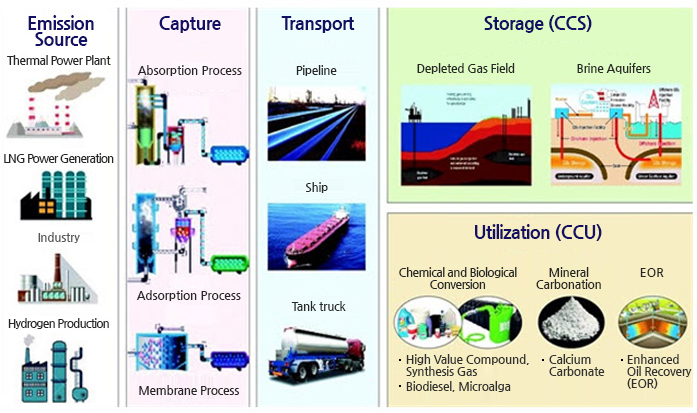Affiliated Homepage Shortcut Button
Kids KOGAS
KOGAS
Current page :
Necessary of Development of Carbon Capture Utilization & Storage (CCUS) Technology
- Due to the rapid increase in fossil fuel consumption, the concentration of greenhouse gas (e.g., CO2) in the atmosphere is increasing; this is closely related to climate change.
- The Korean government is actively promoting greenhouse gas reduction through the 2050 Carbon Neutral Strategy, and KOGAS is contributing to this by producing and distributing hydrogen.
- When hydrogen is produced from natural gas, CO2 is generated during the reforming process. This is expected to reach 1.3 million tons per year, so CCUS technology is required to reduce greenhouse gas emissions.
What is CCUS?
- CCUS is a technology which captures large-scale emitted carbon dioxide, and uses it directly for industrial purposes, converts it into high value products, or isolates it permanently or semi-permanently.
- CCUS is mainly composed of three technologies: collection, utilization, and storage. It is being studied in various fields depending on the characteristics of each technology.
- Carbon dioxide capture is typically classified by process, e.g., absorption process, adsorption process, and membrane process. Since the collection cost accounts for 70~80% of the total cost of CCUS, it is important to reduce this.
- There are several methods of carbon dioxide storage: geological storage (in depleted oil/gas fields, deep aquifers, coal beds, etc.), ocean storage, and surface storage. Geological storage technology has been actively developed and applied in developed regions including North America and Europe since 1996; this has occurred in connection with oil and natural gas projects because these can safely isolate large amounts of carbon dioxide.
- Carbon dioxide utilization is categorized as consumption conversion and non-consumption conversion depending on technical classification. Consumption conversion is conversion into other substances through biological, chemical, photochemical, and electrochemical methods, while non-consumption conversion means commercialization without changing the composition, e.g., manufacturing liquefied carbonic acid or dry ice.
Future Value Using CCUS Technology
Since atmospheric CO2 can be captured not only for storage, but also for conversion into other high value substances, we can effectively reduce greenhouse gas emissions by developing and using CCUS technology.



